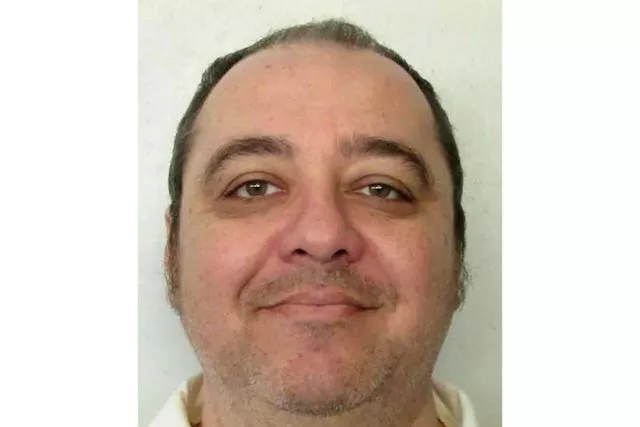A man put to death using nitrogen gas shook and convulsed for minutes on the gurney as Alabama carried out a first-of-its-kind execution.
Breathing through a nitrogen-filled face mask that deprived him of oxygen, 58-year-old convicted killer Kenneth Eugene Smith convulsed in seizure-like spasms for at least two minutes of the 22-minute execution by nitrogen hypoxia on Thursday.
The force of his movements at times caused the gurney to visibly shake. That was followed by several minutes of gasping breathing until his breath was no longer perceptible.
Smith’s supporters expressed alarm at how the execution played out, saying it was the antithesis of the state’s promise of a quick and painless death. But Alabama’s attorney general characterised the execution as “textbook” during a news conference.

“As of last night, nitrogen hypoxia as a means of execution is no longer an untested method. It is a proven one,” Alabama attorney general Steve Marshall said, extending an offer of help for states considering adopting the method.
Asked about Smith’s shaking and convulsing on the gurney, Alabama corrections commissioner John Q Hamm said they appeared to be involuntary movements.
“That was all expected and was in the side effects that we’ve seen or researched on nitrogen hypoxia,” Mr Hamm said. “Nothing was out of the ordinary from what we were expecting.”
Mr Marshall said he anticipated Alabama “will definitely have more nitrogen hypoxia executions”.
More than 40 death row inmates have selected nitrogen as their preferred execution method over lethal injection but did so at a time when the state had not developed nitrogen procedures.
Lawyers for those inmates have asked the court to order Alabama to turn over records and information about Smith’s execution. Litigation will almost certainly focus on Smith’s convulsions and movements during the execution.

“The state promised the world the most humane method of execution known to man. Instead, Mr Smith writhed and thrashed before he died. No further executions should take place by this method until the events of this evening are examined by an independent body,” assistant federal defender John Palombi, who represents death row inmates who requested nitrogen, said in a statement.
Smith’s spiritual adviser, Rev Jeff Hood, agreed that the execution did not match the state attorney general’s prediction that Smith would lose consciousness in seconds followed by death within minutes.
“We didn’t see somebody go unconscious in 30 seconds. What we saw was minutes of someone struggling for their life,” said Mr Hood, who attended the execution.
Dr Philip Nitschke, a euthanasia expert who designed a suicide pod using nitrogen gas and appeared as an expert witness for Smith, said the description of Smith’s thrashing matches what he would expect to happen when nitrogen gas is used in a mask and someone holds their breath or takes the smallest possible breaths.
“I think this outcome is inevitable if the nitrogen gas is to be used in execution where people do not want to die and will not co-operate,” Dr Nitschke said.
Outside the country, the European Union and the UN Human Rights Office expressed regret on Friday over the execution. The 27-nation EU and the Geneva-based UN rights office say the death penalty violates the right to life and does not deter crime.
Smith, who was paid 1,000 dollars to kill an Alabama woman more than 30 years ago, said in a final statement: “Tonight Alabama causes humanity to take a step backwards. I’m leaving with love, peace and light.”
He made the “I love you sign” with his hands towards family members who were witnesses. “Thank you for supporting me. Love, love all of you,” Smith said.
Alabama governor Kay Ivey said the execution was justice for the murder-for-hire killing of 45-year-old Elizabeth Sennett in 1988.
“After more than 30 years and attempt after attempt to game the system, Mr Smith has answered for his horrendous crimes,” Ms Ivey said in a statement. “I pray that Elizabeth Sennett’s family can receive closure after all these years dealing with that great loss.”
Mike Sennett, the victim’s son, said on Thursday night that Smith “had been incarcerated almost twice as long as I knew my mom”.

“Nothing happened here today is going to bring mom back. It’s kind of a bittersweet day. We are not going to be jumping around, whooping and holler, hooray and all that,” he said. “I’ll end by saying Elizabeth Dorlene Sennett got her justice tonight.”
Alabama had previously attempted to execute Smith in 2022, but the lethal injection was called off at the last minute because authorities could not connect an IV line.
The execution came after a last-minute legal battle in which his lawyers contended the state was making him the test subject for an experimental execution method that could violate the constitutional ban on cruel and unusual punishment. Federal courts rejected Smith’s bid to block it, with the final ruling coming on Thursday night from the US Supreme Court.
Liberal justices Sonia Sotomayor, Elena Kagan and Ketanji Brown Jackson dissented.
“Having failed to kill Smith on its first attempt, Alabama has selected him as its ‘guinea pig’ to test a method of execution never attempted before. The world is watching,” Ms Sotomayor wrote.
The White House also expressed concern over the execution method, with press secretary Karine Jean-Pierre saying during a media briefing on Friday that reports about Smith and his death were “very troubling”.
Ms Sennett was found dead in her home on March 18, 1988, with eight stab wounds in the chest and one on each side of her neck. Smith was one of two men convicted in the killing. The other, John Forrest Parker, was executed in 2010.
Prosecutors said they were each paid 1,000 dollars to kill Ms Sennett on behalf of her pastor husband, who was deeply in debt and wanted to collect on insurance. The husband, Charles Sennett Senior, killed himself when the investigation focused on him as a suspect, according to court documents.







